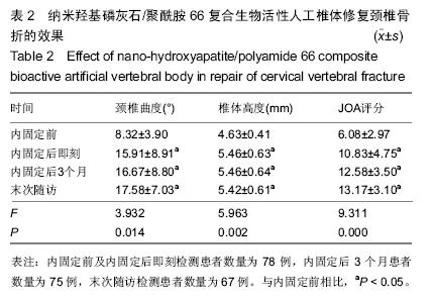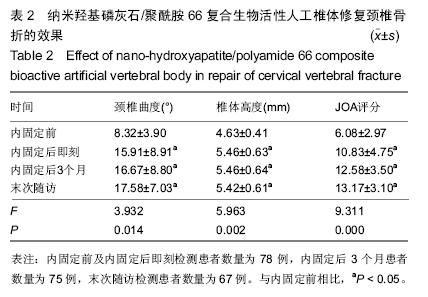[1] Laurie SW, Kaban LB, Mulliken JB, et al. Donor-site morbidity after harvesting rib and iliac bone. Plast Reconstr Surg. 1984; 73(6):933-938.
[2] 何清义,吴雪晖,周强,等.同种异体髂骨结合钢板在颈椎前路手术中的应用[J].中国矫形外科杂志,2008,16(5):6328-6331.
[3] Pelker RR, Friedlaender GE. Biomechanical aspects of bone autografts and allografts. Orthop Clin North Am. 1987;18 (2): 235-239.
[4] Das K, Couldwell WT, Sava G, et al. Use of cylindrical titanium mesh and locking plates in anterior cervical fusion. Technical note. J Neurosurg. 2001;94(1 Suppl):174-178.
[5] Harrison DE, Harrison DD, Cailliet R, et al. Cobb method or Harrison posterior tangent method: which to choose for lateral cervical radiographic analysis. Spine (Phila Pa 1976). 2000; 25(16):2072-2078.
[6] Dirschl DR. Scoring of orthopaedic residency applicants: is a scoring system reliable? Clin Orthop Relat Res. 2002; (399): 260-264.
[7] Brantigan JW, Steffee AD, Lewis ML, et al. Lumbar interbody fusion using the Brantigan I/F cage for posterior lumbar interbody fusion and the variable pedicle screw placement system: two-year results from a Food and Drug Administration investigational device exemption clinical trial. Spine (Phila Pa 1976). 2000;25(11):1437-1446.
[8] Chuang HC, Cho DY, Chang CS, et al. Efficacy and safety of the use of titanium mesh cages and anterior cervical plates for interbody fusion after anterior cervical corpectomy. Surg Neurol. 2006;65(5):464-471; discussion 471.
[9] Daubs MD. Early failures following cervical corpectomy reconstruction with titanium mesh cages and anterior plating. Spine (Phila Pa 1976). 2005;30(12):1402-1406.
[10] Thalgott JS, Xiongsheng C, Giuffre JM. Single stage anterior cervical reconstruction with titanium mesh cages, local bone graft, and anterior plating. Spine J. 2003;3(4):294-300.
[11] 李新友,王金堂,韩学哲,等.颈前路椎体次全切钛网植骨早期下沉的探讨.美中国际创伤杂志,2004,3(3):18-20.
[12] 马永刚,刘世清,李亚明,等.颈椎前路减压融合术后钛笼下沉临床分析[J].中国脊柱脊髓杂志,2011,21(1):21-23.
[13] Gercek E, Arlet V, Delisle J, et al. Subsidence of stand-alone cervical cages in anterior interbody fusion: warning. Eur Spine J. 2003;12(5):513-516.
[14] 许艳慧,李四群,李志安.纳米羟基磷灰石复合材料的研究——纳米羟基磷灰石的细胞毒性[J].实用口腔医学杂志, 2004, 20 (2): 147-150.
[15] 孟纯阳,安洪,蒋电明.新型纳米骨关节修复重建材料的生物活性及近期对机体钙磷代谢的影响[J].中国骨与关节损伤杂志, 2005, 20(10):682-684.
[16] 孟纯阳,安洪,蒋电明,等.网孔纳米羟基磷灰石/聚酰胺人工骨修复兔桡骨缺损[J].中华创伤杂志,2005,21(3):187-191.



